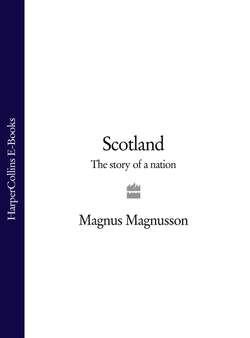Читать книгу Scotland: The Story of a Nation - Magnus Magnusson - Страница 25
Dunadd
ОглавлениеThe massive natural fortress of Dunadd, in mid-Argyll, rears out of the Crinan Moss (Moine Mhor – the ‘great moss’) at the southern end of the fertile Kilmartin Glen above Lochgilphead. For historical pilgrims intent on getting a ‘feel’ for ancient Dalriada, there is a new Museum and Visitor Centre (Kilmartin House) in the village of Kilmartin at the head of the valley.2
The hill-fort of Dunadd is only one of the many power-bases of the old kingdom of Dalriada, but it is perhaps the most striking and evocative. It stands back from the A816 from Lochgilphead to Oban, fifty-four metres high, a grass-grown rock mass made of epidiorite schist and shaped by glacial action – what geologists call a roche moutonnée. It is a bit of a scramble in places to reach the top, through natural clefts in the rock, but there is a wonderful panoramic view from the summit which makes the effort well worth while.
The steep zigzag route to the summit leads through two defiles which give access to concentric terraces which girdle it. The terraces are buttressed by the living rock, and any gaps were filled in by walling to complete the defences. The terraces provided space for timber structures, no trace of which now remains. The path leads onwards and upwards to the highest of the terraces, just below the sanctuary of the summit. On this grassy shelf lies the magnet which draws visitors to the top: a carved footprint incised into the bedrock, pointing more or less directly towards the distant Ben Cruachan, the ‘holy mountain’ of Argyll. There is also a roughly-scratched outline of a boar (a Pictish symbol) and an inscription in the unintelligible alphabet known as ogam. On another rock, just behind the ‘heel’ of the footprint, is a small hollowed-out basin (possibly for libations).
It is a tantalisingly enigmatic spot, where the imagination can take wing. Most commentators now agree that the carved footprint was used in the ritual inauguration of early Dalriadic kings; the new king would have placed one foot in the carving during the ceremony, in full view of his people gathered on the terrace below, to symbolise a royal ‘marriage’ with the land. Today’s visitors cannot resist trying the fit for themselves.1
There is a magic resonance about Dunadd; for the people of Argyll it is the birthplace of the Scottish nation, a royal centre of major importance in the growth of ‘Scotland’ as a coherent realm. It has an overwhelming sense of place, of belonging to the land, superintending the surrounding countryside: the coiling meanders of the River Add below, Kilmartin Glen to the north, the hills of Knapdale to the south and, to the west, the Crinan Estuary and the Sound of Jura marking the route of the incomers from Antrim.
Recent archaeological excavations have shown that Dunadd was occupied, albeit intermittently, from about AD 500 to 1000; it is usually called ‘the capital’ – or ‘a capital’ – of the kings of Dalriada. It was a place where skilled craftspeople fashioned high-quality jewellery and implements in bronze, silver and gold. It was also a major trading centre in a huge Celtic network which stretched from Ireland, down the west coast of Britain and across to the Mediterranean. Dunadd was clearly an important player in European trade, exporting commodities like hides, leather and metal-work and importing luxury goods from abroad. One of the most intriguing items found during excavations at Dunadd was a small piece of a yellow mineral named orpiment which comes from the Mediterranean; orpiment is the mineral which produced the beautiful golden yellow ink used by medieval scribes for their illuminated manuscripts, and may have been used on Iona to make the Book of Kells. Adomnán, the biographer of St Columba, described a visit paid by Columba to the caput regionis (capital of the region) and his talking to sailors from Gaul – perhaps he was there to buy orpiment for his scriptorium on Iona!
Ted Cowan, Professor of Scottish History at Glasgow University, says of the carved footprint on Dunadd:
The new king of Dalriada metaphorically (and almost literally) stepped into the shoes of the old king – it’s a perfect size nine shoe, by the way. It carried overtones of fitting the role of being king, of being the only person whose foot fitted the footprint; the last echo of that concept is heard in the story of Cinderella and the glass slipper – the Ugly Sisters try it on, but Cinderella, the ‘real’ princess, is the only person whose foot fits.
These inaugurations would have been Christian ceremonies, whatever ancient pagan traditions may have been reflected in them. And that brings us to a consideration of the impact of Christianity on early Scotland.
